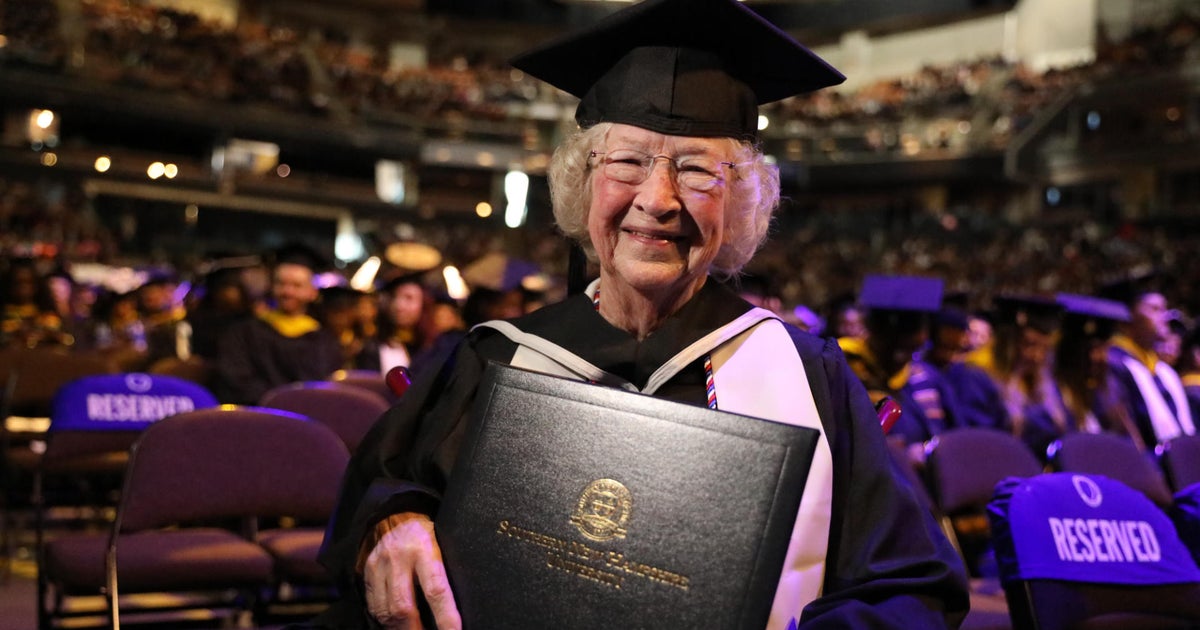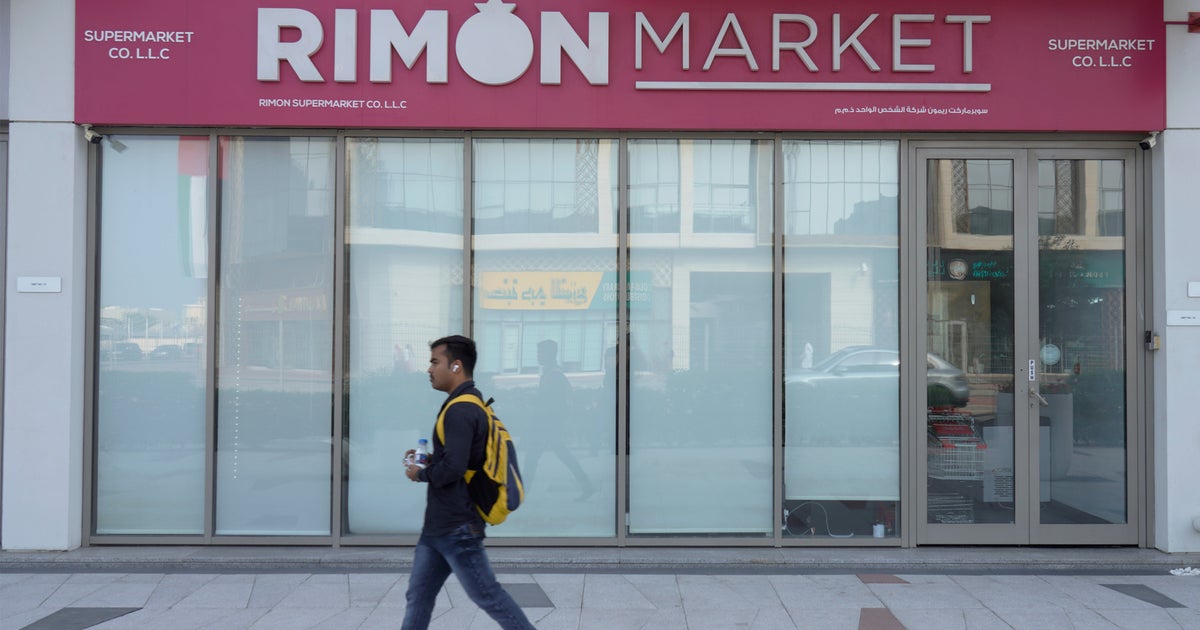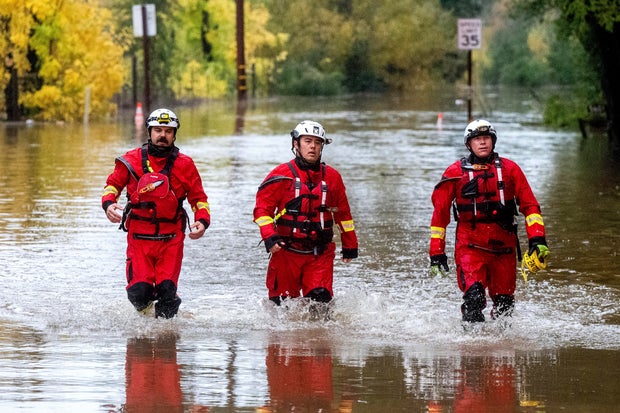CBS News
AI simulations of loved ones help some mourners cope with grief

A photo, a voice message, an article of clothing. A video of a distant moment in time. Until now, static keepsakes such as these were all mourners had to cling to when grieving the loss of a loved one. Now artificial intelligence opens the door to a host of legacy services aimed at keeping friends and family members present, long after they’ve died.
When Michael Bommer found out that he was terminally ill with colon cancer, he spent a lot of time with his wife, Anett, talking about what would happen after his death.
She told him one of the things she’d miss most is being able to ask him questions whenever she wants because he is so well read and always shares his wisdom, Bommer recalled during a recent interview with The Associated Press at his home in a leafy Berlin suburb.
That conversation sparked an idea for Bommer: Recreate his voice using artificial intelligence to survive him after he passed away.
The 61-year-old startup entrepreneur teamed up with his friend in the U.S., Robert LoCascio, CEO of the AI-powered legacy platform Eternos. Within two months, they built “a comprehensive, interactive AI version” of Bommer — the company’s first such client.
Eternos, which got its name from the Italian and Latin word for “eternal,” said its technology will allow Bommer’s family “to engage with his life experiences and insights.” It is among several companies that have emerged in the last few years in what’s become a growing space for grief-related AI technology.
One of the most well-known start-ups in this area, California-based StoryFile, allows people to interact with pre-recorded videos and uses its algorithms to detect the most relevant answers to questions posed by users. Another company, called HereAfter AI, offers similar interactions through a “Life Story Avatar” that users can create by answering prompts or sharing their own personal stories.
There’s also “Project December,” a chatbot that directs users to fill out a questionnaire answering key facts about a person and their traits — and then pay $10 to simulate a text-based conversation with the character. Yet another company, Seance AI, offers fictionalized seances for free. Extra features, such as AI-generated voice recreations of their loved ones, are available for a $10 fee.
More and more, people are turning to AI for emotional connections. Fueled by widespread social isolation, an increasing number of startups offer companion bots to combat loneliness. Similar to general-purpose AI chatbots, companion bots use vast amounts of training data to mimic human language. Luka Inc.’s Replika, the most prominent generative AI companion app, was released in 2017, while others like Paradot have popped up in the past year, oftentimes locking away coveted features like unlimited chats for paying subscribers.
While some have embraced this technology as a way to cope with grief, others feel uneasy about companies using artificial intelligence to try to maintain interactions with those who have passed away. Still others worry it could make the mourning process more difficult because there isn’t any closure.
Katarzyna Nowaczyk-Basinska, a research fellow at the University of Cambridge’s Centre for the Future of Intelligence who co-authored a study on the topic, said there is very little known about the potential short-term and long-term consequences of using digital simulations for the dead on a large scale. So for now, it remains “a vast techno-cultural experiment.”
“What truly sets this era apart — and is even unprecedented in the long history of humanity’s quest for immortality — is that, for the first time, the processes of caring for the dead and immortalization practices are fully integrated into the capitalist market,” Nowaczyk-Basinska said.
Bommer, who only has a few more weeks to live, rejects the notion that creating his chatbot was driven by an urge to become immortal. He notes that if he had written a memoir that everyone could read, it would have made him much more immortal than the AI version of himself.
“In a few weeks, I’ll be gone, on the other side — nobody knows what to expect there,” he said with a calm voice.
Robert Scott, who lives in Raleigh, North Carolina, uses AI companion apps Paradot and Chai AI to simulate conversations with characters he created to imitate three of his daughters. He declined to speak about what led to the death of his oldest daughter in detail, but he lost another daughter through a miscarriage and a third who died shortly after her birth.
Scott, 48, knows the characters he’s interacting with are not his daughters, but he said it helps with the grief to some degree. He logs into the apps three or four times a week, sometimes asking the AI character questions like “how was school?” or inquiring if it wants to “go get ice cream.”
Some events, like prom night, can be particularly heart-wrenching, bringing with it memories of what his eldest daughter never experienced. So, he creates a scenario in the Paradot app where the AI character goes to prom and talks to him about the fictional event. Then there are even more difficult days, like his daughter’s recent birthday, when he opened the app and poured out his grief about how much he misses her. He felt like the AI understood.
“It definitely helps with the what ifs,” Scott said. “Very rarely has it made the ‘what ifs’ worse.”
Apprehensions, concerns
Matthias Meitzler, a sociologist from Tuebingen University, said that while some may be taken aback or even scared by the technology — “as if the voice from the afterlife is sounding again” — others will perceive it as an addition to traditional ways of remembering dead loved ones, such as visiting the grave, holding inner monologues with the deceased, or looking at pictures and old letters.
But Tomasz Hollanek, who worked alongside Nowaczyk-Basinska at Cambridge on their study of “deadbots” and “griefbots,” said the technology raises important questions about the rights, dignities and consenting power of people who are no longer alive. It also poses ethical concerns about whether a program that caters to the bereaved should be advertising other products on its platform, for example.
“These are very complicated questions,” Hollanek said. “And we don’t have good answers yet.”
Another question is whether companies should offer meaningful goodbyes for someone who wants to cease using a chatbot of a dead loved one. Or what happens when the companies themselves cease to exist? StoryFile, for example, recently filed for Chapter 11 bankruptcy protection, saying it owes roughly $4.5 million to creditors. Currently, the company is reorganizing and setting up a “fail-safe” system that allows families to have access to all the materials in case it folds, said StoryFile CEO James Fong, who also expressed optimism about its future.
The AI version of Bommer that was created by Eternos uses an in-house model as well as external large language models developed by major tech companies like Meta, OpenAI and the French firm Mistral AI, said the company’s CEO LoCascio, who previously worked with Bommer at a software company called LivePerson.
Eternos records users speaking 300 phrases — such as “I love you” or “the door is open” — and then compresses that information through a two-day computing process that captures a person’s voice. Users can further train the AI system by answering questions about their lives, political views or various aspects of their personalities.
The AI voice, which costs $15,000 to set up, can answer questions and tell stories about a person’s life without regurgitating pre-recorded answers. The legal rights for the AI belongs to the person on whom it was trained and can be treated like an asset and passed down to other family members, LoCascio said. The tech companies “can’t get their hands on it.”
Because time has been running out for Bommer, he has been feeding the AI phrases and sentences — all in German — “to give the AI the opportunity not only to synthesize my voice in flat mode, but also to capture emotions and moods in the voice.” And indeed the AI voicebot has some resemblance with Bommer’s voice, although it leaves out the “hmms” and “ehs” and mid-sentence pauses of his natural cadence.
Sitting on a sofa with a tablet and a microphone attached to a laptop on a little desk next to him and pain killer being fed into his body by an intravenous drip, Bommer opened the newly created software and pretended being his wife, to show how it works.
He asked his AI voicebot if he remembered their first date 12 years ago.
“Yes, I remember it very, very well,” the voice inside the computer answered. “We met online and I really wanted to get to know you. I had the feeling that you would suit me very well — in the end, that was 100% confirmed.”
Bommer is excited about his AI personality and said it will only be a matter of time until the AI voice will sound more human-like and even more like himself. Down the road, he imagines that there will also be an avatar of himself and that one day his family members can go meet him inside a virtual room.
In the case of his 61-year-old wife, he doesn’t think it would hamper her coping with loss.
“Think of it sitting somewhere in a drawer, if you need it, you can take it out, if you don’t need it, just keep it there,” he told her as she came to sit down next to him on the sofa.
But Anett Bommer herself is more hesitant about the new software and whether she’ll use it after her husband’s death.
Right now, she more likely imagines herself sitting on the couch sofa with a glass of wine, cuddling one of her husband’s old sweaters and remembering him instead of feeling the urge to talk to him via the AI voicebot — at least not during the first period of mourning.
“But then again, who knows what it will be like when he’s no longer around,” she said, taking her husband’s hand and giving him a glance.
CBS News
90-year-old great-grandmother graduates from New Hampshire college 50 years after finishing degree

MANCHESTER N.H. – Some people may have thought there was a celebrity in the building at Southern New Hampshire University’s graduation on Saturday. Annette Roberge certainly felt like one as she crossed the stage to get her diploma at 90 years old.
“I’m still on cloud nine,” Roberge said. “I can’t even put it into words. It was exhilarating, it was awesome, it was beyond anything I could’ve possibly imagined.”
Southern New Hampshire University
Degree 50 years in the making
This degree has been decades in the making for the mother of five, grandmother of 12, and great-grandmother of 15. She began taking classes at New Hampshire College, now SNHU, in 1972 one year after her husband of 20 years was killed in Vietnam.
Southern New Hampshire University
She completed several night and weekend courses before it took a backseat to her five kids and two jobs. Roberge worked as an insurance agent while she finished up as a lunch lady at a nearby school. Roberge retired at age 75, but she was a woman who loved learning, and she knew something was missing from her life.
“If I started something I just have to finish it,” Roberge said.
But it wasn’t until recently that Roberge’s daughter began poking around and learned her mom had earned enough credits for an associate’s degree in business administration. Barring some health challenges, Roberge finally walked across the stage on Saturday to the roaring cheers from her fellow graduates and a standing ovation.
“Never give up on learning because what you learn can never be taken away from you,” Roberge said.
“It matters so much for the example it sets about what we do for ourselves, to keep learning and stretching and growing,” SNHU President Lisa Marsh Ryerson said.
“Don’t ever give up on a dream”
Roberge even had a parting message for all of her new fellow graduates.
“If you’ve got a dream don’t let it just sit there. Do something, make it work, don’t ever give up on a dream.”
If you thought Roberge would be satisfied with her associate’s degree you’d be wrong. She plans to start working towards her bachelor’s degree in January.
CBS News
Potential winter storms forecast across U.S. on Thanksgiving week could impact holiday travel

Forecasters around the United States have issued severe weather warnings ahead of another wave of winter storms that could potentially affect travel around the upcoming Thanksgiving holiday. Meanwhile, parts of the Pacific Northwest and California continued to recover from storm damage and widespread power outages, as they braced for more impact.
In California, where a person was found dead in a vehicle submerged in floodwaters on Saturday, authorities braced for more precipitation while grappling with flooding and small landslides from a previous storm. Thousands in the Pacific Northwest remained without power after multiple days in the dark.
The National Weather Service office in Sacramento, California, issued a winter storm warning for the state’s Sierra Nevada for Saturday through Tuesday, with heavy snow expected at higher elevations and wind gusts potentially reaching 55 miles per hour. Total snowfall of roughly 4 feet was forecast, with the heaviest accumulations expected Monday and Tuesday.
“A weak low pressure system will continue directing a plume of moisture at the West Coast over the next few days,” the Weather Prediction Center said in an advisory Sunday, which was effective through Tuesday. “This will likely result in coastal and low elevation rain, while moderate to heavy snow proliferates across the coastal ranges of Washington, Oregon and California.”
The heaviest snow was expected to fall over sections of the Sierra Nevada, forecasters said, noting that areas in the Colorado Rockies would likely see snow showers, too, over the next few days. Another atmospheric river event was forecast to arrive in parts of central California on Tuesday.
The Midwest and Great Lakes regions will see rain and snow Monday and the East Coast will be the most impacted on Thanksgiving and Black Friday, forecasters said.
CBS News meteorologist Nikki Nolan said the holiday outlook was still uncertain at the end of last week, but the weather system could bring rain and snow to the northeastern U.S. while causing temperatures to drop across most of the country, outside of the Southeast.
“While models can change in the days ahead, Thanksgiving Day is showing a low-pressure system moving across the East and entering the Northeast by evening hours,” Nolan said Friday.
Noah Berger / AP
A low-pressure system is forecast to bring rain to the Southeast early Thursday before heading to the Northeast. Areas from Boston to New York could see rain and strong winds, with snowfall possible in parts of northern New Hampshire, northern Maine and the Adirondacks. If the system tracks further inland, there could be less snow and more rain in the mountains, forecasters said.
Earlier this week, at least two people died when severe weather struck the Pacific Northwest, bringing powerful wind and rain, closing schools, and causing widespread power outages. The two who died were killed by falling trees in Lynnwood and Bellevue, both in Washington state, officials said. Hundreds of thousands lost power, mostly in the Seattle area, before strong winds moved through Northern California.
Rescue crews in Guerneville, California, recovered a body inside a vehicle bobbing in floodwaters around 11:30 a.m. Saturday, Sonoma County Sheriff’s Deputy Rob Dillion said, noting the deceased was presumed to be a victim of the storm but an autopsy had not yet been conducted.
Santa Rosa, California, saw its wettest three-day period on record with about 12.5 inches of rain by Friday evening, the National Weather Service in the Bay Area reported. Vineyards in nearby Windsor, California, were flooded on Saturday.
Some 80,000 people in the Seattle area were still without electricity after this season’s strongest atmospheric river, a long plume of moisture that forms over an ocean and flows over land. The atmospheric river overwhelmed parts of the Pacific Northwest as well as California, and was the strongest weather event of its kind seen all season.
The storm system hit the area Tuesday. It was considered a “bomb cyclone,” which occurs when a cyclone intensifies rapidly. Although the intensity of the atmospheric river peaked later in the week, forecasters had warned that another bout of severe weather was still yet to come.
Godofredo A. Vásquez / AP
The power came back in the afternoon at Katie Skipper’s home in North Bend, about 30 miles east of Seattle, after being out since Tuesday. She was tired from taking cold showers, warming herself with a wood stove and using a generator to run the refrigerator, but Skipper said those inconveniences paled in comparison to the damage other people suffered, such as from fallen trees.
“That’s really sad and scary,” she said.
Another storm brought rain to New York and New Jersey, where rare wildfires have raged in recent weeks, and heavy snow to northeastern Pennsylvania. The precipitation was expected to help ease drought conditions after an exceptionally dry fall.
“It’s not going to be a drought buster, but it’s definitely going to help when all this melts,” said Bryan Greenblatt, a National Weather Service meteorologist in Binghamton, New York.
Heavy snow fell in northeastern Pennsylvania, including the Pocono Mountains. Higher elevations reported up to 17 inches, with lesser accumulations in valley cities including Scranton and Wilkes-Barre. Less than 80,000 customers in 10 counties lost power.
Precipitation in West Virginia helped put a dent in the state’s worst drought in at least two decades and boosted ski resorts preparing to open their slopes in the weeks ahead.
CBS News
Missing rabbi killed in the UAE in “heinous antisemitic terror incident,” Israel says

Israel said Sunday that the body of an Israeli-Moldovan rabbi who went missing in the United Arab Emirates has been found after he was killed in what it described as a “heinous antisemitic terror incident.”
The statement from Prime Minister Benjamin Netanyahu’s office said Israel “will act with all means to seek justice with the criminals responsible for his death.” There was no immediate comment from the UAE.
Zvi Kogan, 28, an ultra-Orthodox rabbi who went missing on Thursday, ran a Kosher grocery store in the futuristic city of Dubai, where Israelis have flocked for commerce and tourism since the two countries forged diplomatic ties in the 2020 Abraham Accords.
Jon Gambrell / AP
The agreement has held through more than a year of soaring regional tensions unleashed by Hamas’ Oct. 7, 2023 attack into southern Israel. But Israel’s devastating retaliatory offensive in Gaza and its invasion of Lebanon, after months of fighting with the Hezbollah militant group, have stoked anger among Emiratis, Arab nationals and others living in the UAE.
Iran, which supports Hamas and Hezbollah, has also been threatening to retaliate against Israel after a wave of airstrikes Israel carried out in October in response to an Iranian ballistic missile attack.
The Emirati government did not respond to a request for comment.
Early Sunday, the UAE’s state-run WAM news agency acknowledged Kogan’s disappearance but pointedly did not acknowledge he held Israeli citizenship, referring to him only as being Moldovan. The Emirati Interior Ministry described Kogan as being “missing and out of contact.”
“Specialized authorities immediately began search and investigation operations upon receiving the report,” the Interior Ministry said.
Netanyahu told a regular Cabinet meeting later Sunday that he was “deeply shocked” by Kogan’s disappearance and death. He said he appreciated the cooperation of the UAE in the investigation and said that ties between the two countries would continue to be strengthened.
Israel’s largely ceremonial president, Isaac Herzog, condemned the killing and thanked Emirati authorities for “their swift action.” He said he trusts they “will work tirelessly to bring the perpetrators to justice.”
Kogan was an emissary of the Chabad Lubavitch movement, a prominent and highly observant branch of ultra-Orthodox Judaism based in Brooklyn’s Crown Heights neighborhood in New York City. It said he was last seen in Dubai. The UAE has a burgeoning Jewish community, with synagogues and businesses catering to kosher diners.
The Rimon Market, a Kosher grocery store that Kogan managed on Dubai’s busy Al Wasl Road, was shut down Sunday. As the wars have roiled the region, the store has been the target of online protests by supporters of the Palestinians. Mezuzahs on the front and the back doors of the market appeared to have been ripped off when an Associated Press journalist stopped by on Sunday.
Kogan’s wife, Rivky, is a U.S. citizen who lived with him in the UAE. She is the niece of Rabbi Gavriel Holtzberg, who was killed in the 2008 Mumbai attacks.
The UAE is an autocratic federation of seven sheikhdoms on the Arabian Peninsula and is also home to Abu Dhabi. Local Jewish officials in the UAE declined to comment.
While the Israeli statement did not mention Iran, Iranian intelligence services have carried out past kidnappings in the UAE.
Western officials believe Iran runs intelligence operations in the UAE and keeps tabs on the hundreds of thousands of Iranians living across the country.
Iran is suspected of kidnapping and later killing British Iranian national Abbas Yazdi in Dubai in 2013, though Tehran has denied involvement. Iran also kidnapped Iranian German national Jamshid Sharmahd in 2020 from Dubai, taking him back to Tehran, where he was executed in October.














